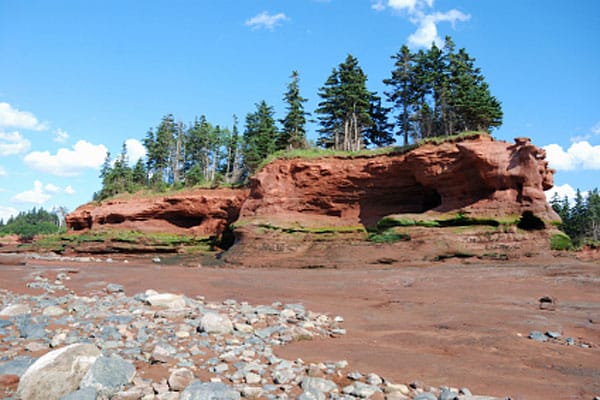Since he bought his Northumberland Strait cottage nearly 10 years ago, Bill Porter has spent more than $35,000 just trying to hold onto his shorefront property. Having borne the brunt of many fall storms, Porter’s property looks a lot different now than it did when the land was first surveyed.
Originally, he says, his property was 150 feet deep and there was a road along the shore. “The road is long gone and, right now, the depth of the lot from the crest to the front of the cottage is probably about 50 or 60 feet.”
Each year, Porter has a local company bring in truckloads of stone in an effort to shore up the bank and hold onto his property. He also bought a neighbouring property four or five years ago. “The second cottage we bought was a tear-down. The erosion was so bad it was almost to the deck of the cottage.”
Erosion is nothing new to people who live near the water. Shifting and changing shorelines are a natural part of ocean geography. It is, however, becoming more and more of a problem for cottage owners in Atlantic Canada. The Northumberland Strait, the Minas Basin, the Atlantic coasts of eastern New Brunswick, PEI and Nova Scotia and parts of Cape Breton including the Bras d’Or Lakes are at greatest risk. Even the increasingly populated areas near Halifax are threatened.
While it is true that sea levels are rising, coastal geomorphologist, Bob Taylor, of the Bedford Institute of Oceanography, in Dartmouth, NS, says the problem lies with the shorefront becoming more and more populated.
“The real enemy is us,” Taylor says. He points out that people used to build simple cottages on the shorefront. After about 40 years, when the sea caught up with them, they would simply relocate to a new cottage farther inland. Taylor says the value of the house and the land have become so high now that people often decide to hold their ground—even build up.
“People will rip down small cottages and then build large residences,” he says. He calls it “mansionization.”
“All of a sudden, there’s no buffer between them and the sea,” says Taylor. “They have to make a major decision about what to do to protect their shoreline.”
While Taylor warns against messing with the natural geography of the shoreline, he also understands that some people feel they need to protect their property. “You only have three options,” he says. “Defend, adapt or retreat.” He says the first thing people need to do, before making any decisions, is to understand the problem. “People often buy real estate and build things in nice weather. They don’t stick around to watch what happens during bad weather. Our nor’easters from November to March can be quite catastrophic.”

Taylor says that one of the keys to solving erosion problems is to determine the time of year when the worst of the erosion is happening. Are fall and winter storms taking big chunks of the bank, or is sea ice eating the bank?
Elayne Lord owns seven acres of land on the Prince Edward Island side of the Northumberland Strait that have been in her family for four generations. She remembers, one winter, finding a chunk of an iceberg that had been pushed all the way up her 15-foot bank. As it melted, it took huge sections of land in the runoff.
Last winter, a January storm took all of the $35,000 in rock she had put in place less than a year before. She admits that she cried over the expense of losing the rock, but says she eventually realized how lucky she was. Her neighbour lost 20 feet of land in the same storm. “My rock is gone, but maybe the ocean took my rock instead of my land.”
Homeowners should take into consideration the impact of erosion on the whole shoreline, not just on their own property, when developing a plan.
Dan Cress, the owner of Wetlands Engineering and Construction, based in Pugwash, NS, says he’s had a lot of luck preventing erosion on the Northumberland shore by placing smaller rocks along the banks, then placing large three- or four-tonne boulders in front of those. In some cases, he says, rock placed 30 years ago is still holding steady, but he notes the rock encourages the water to wrap around the stone, eating away at the beach or bank on either side.
Cress says he’s seen some properties that have been eroded almost down to a point. “It can cause problems between neighbours and can even land the property owners in court.”
Bob Taylor says the best solution to any erosion problem is to mimic nature as closely as possible. Whether it’s strong local grasses that hold onto the topsoil, or large trees holding big chunks of land intact, he says, vegetation can be a useful defence.
Elayne Lord’s sister owns the property next to hers. The undeveloped land is still mostly covered with trees. “Her land is sticking out more than mine, which tells me the trees are holding the land intact,” she says.
Trees near the edge of a cliff should be cut off at the base, suggests Taylor, leaving the stump and the roots intact. “The roots hold the bank in place but you don’t have all that weight of the tree swaying around in the wind, which can pull up the ground if the tree falls over.”
Taylor counsels property owners to take their time to get to know their property and the ocean patterns. Not only do the tides come and go, but so does the beach.
“If you have left enough room between yourself and the sea, you’ll be able to watch your beach change shape and adapt to different conditions, without having to worry. I’ve seen a lot of devastation,” he says, “but I’ve also seen shorelines rebuild themselves within six months.”
